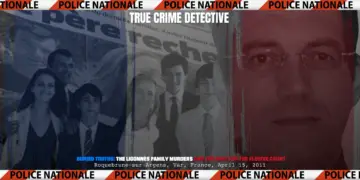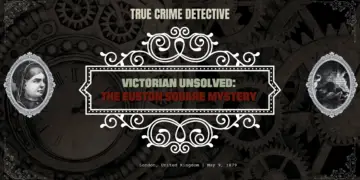
Buried Truths: The Ligonnès Family Murders and the Hunt for the Elusive Count
Criminal history is littered with the most terrible people and the most brutal of crimes. But few crimes genuinely have the power to shock and disgust more than those where a parent is responsible for killing their children. Worse, are those killers who decide to murder their entire families. Into this world steps Count Xavier Dupont de Ligonnès. Born in Versailles, France, Ligonnès stands accused of murdering his wife, four children, and two dogs before vanishing into thin air, never to be seen again. Yet, questions remain surrounding the 2011 slaughter, with the foremost being just where is Xavier Dupont de Ligonnès?
The Dupont de Ligonnès family is steeped in French aristocratic history, having shortened their name from Molin du Pont de Ligonnès in the 17th century. They once owned the Château du Pont-de-Mars in Chambon-sur-Lignon, between the 16th and 18th centuries alongside other immense property such as Le Château Ducal d’Uzès. Prominent family members included Édouard du Pont de Ligonnès, his son Bishop Charles du Pont de Ligonnès and the war hero and Knight of the Légion d’honneur Bernard Dupont, 6th Marquis de Ligonnès.
Ligonnès had a charmed life, seemingly happily married to his wife Agnès and blessed with four children, Arthur, Thomas, Anne, and Benoît. Despite the family heritage, the six lived together in a modest house at 55 Boulevard Robert-Schuman in Nantes, and Xavier worked as a salesman. Seemingly unsatisfied with his life; however, he attempted to create several businesses catering to travelling salespeople, all with little success, perhaps as the family was known to often be in debt, including €20,000 in the hands of a bailiff. Yet, one of these businesses continues to be a mystery. Formed just before 2006, SELREFs purpose has been defined as secretive, with only the bare minimum information ever released to authorities. Xavier hired six salespeople to the company in 2003, freeing them from their contracts not long afterwards.

Another company that would significantly impact the case was Netsurf Concept LLC, registered in Florida. The advisor to the endeavor was Gérard Corona, specialising in assisting foreign nationals in the United States. His other work includes helping his clients obtain anonymous bank cards, opening foreign bank accounts, and generally ensuring they leave no paper trail. Why Xavier would be involved in such enterprises is unknown.
Agnès, meanwhile, was a devout Catholic and was an assistant at the local Blanche-de-Castille Catholic School in Nantes. She regularly attended mass with her children, and she was described as firm but fair with them. Arthur was born to another father but was recognized by Xavier when he married Agnès in 1992. By 2011, he was studying for a technical diploma in IT an hour away from Nantes while working as a waiter at a pizzeria. Thomas, meanwhile, was passionate about music and was studying at the Catholic University of the West in Angers, living in halls of residence and said to be quiet and “very discreet.”
Anne was very much her mother’s daughter, being profoundly religious but still approachable. Like Arthur, she had an interest in science. The youngest, Benoît, was just 13 and also Catholic, being an altar server at Saint-Félix Church in Nantes. Seemingly, the six were a perfect French family, devoted to Catholicism and steeped in the country’s rich history. Yet, in April of 2011, events in Nantes would leave at least five of them dead, with nobody truly knowing why.
The Nantes Horror

The story of the Dupont de Ligonnès family truly begins in July of 2010 when Xavier sends two curious emails to friends, writing that there may one day be “accidents” that have happened to his family he might be blamed for. Prophetically, Xavier would say that, “I hope that, even after a police investigation, my parents, brothers, and sisters will never be led to believe that I intentionally caused these accidents (even if the evidence is strong).”
By March of the following year, strange events started to be connected to the family. Xavier registered himself at the Charles Des Jamonières shooting range and visited four times in just six days, having ordered a firearms license just a month earlier. The father seemingly wanted all the boys in his household to take up shooting, with Thomas and Benoît starting straight away and Arthur scheduled to start soon. Rifle bullets were purchased, and they wouldn’t be the only alarming thing bought, with Xavier purchasing large bin liners and a box full of adhesive plastic paving slabs. Not unusual in itself, but by April 1, he’d added cement, a shovel, and a hoe to his list and on April 2 bought four 10kg bags of lime.
Lime and its heated offshoot, quicklime, are often utilized to aid the disposal of human remains that cannot be given a deep burial. The lime prevents purification and stops the smells and insects usually associated with a decaying corpse. Coupled with his purchase of cement, bin liners, and a shovel, it’s easy to believe that Xavier had just constructed himself a corpse disposal kit.

On April 1, 2011, Arthur had returned from college. Still, he negated attending work at the pizzeria, particularly unusual as the young man typically picked up his wages on the first of the month. However, the family was still alive on Sunday, April 3, as they were seen dining out together, all said to have looked well. Fabrice, a neighbor, reported seeing Agnès, and Xavier left a message on his sister’s answer machine.
However, by the morning of April 4, it became apparent that all was not well with the family after Anne and Benoît failed to attend school, their absence put down to “illness.” Friends were unable to contact the duo, and that evening Xavier dined out alone with Thomas at La Croix Cadeau, a fancy restaurant near Angers. The two were barely speaking, and the boy began to feel unwell before they left. Despite the unusual events, Xavier’s sister spoke on the phone with him following the answering machine message the day before, and all was again said to be okay.
Investigators believe that by this time, however, Agnès, Anne, Benoît, and Arthur were likely already dead with Xavier murdering Thomas that night. How true this is might be vitally important to the investigation with neighbors and witnesses completely contradicting the police theories.
Neighbours state that they clearly saw Agnès alive outside her home on April 5 and April 7, with an employee from a hairdressing salon coming to pick up wages from her on the 5th. A neighbour stated that on the 7th, they saw her walking her dog and that they “spoke briefly, then I cut our chat short because I had an important appointment.” This statement is clearly not able to be dismissed as a possible case of mistaken identity, nor a second witness statement from a friend that placed her in a shop on the same day, perhaps even as late as April 8. Once again, the person was already known to Agnès and unlikely to make such a mistake.
“The newspapers say the autopsies put her death on the 4th [April], but I’m almost convinced I saw her on the evening of Thursday the 7th because I know I didn’t have much time to speak to her as I pick up my son from the childminder every Thursday evening.” – Neighbour, RTL
The question of Agnès wouldn’t be the only mystery over the police timelines, with a friend of Thomas saying that he was still alive on April 5 and spent the entire afternoon with him. Thomas had planned to stay the night, but Xavier called him home and told his son that his mother had been in a cycling accident, Thomas taking the 10pm train back to Nantes. The following day, Thomas or somebody with his phone sent a text saying he wasn’t coming back that day as he was “really ill.”
Around this time, neighbours reported the two family dogs howling for two nights in a row before going silent while Arthur’s girlfriend visited the house on April 6, also saying that the dogs made no noise despite her knocking loudly on the front door.
On the 7th, the same day that a neighbour clearly recalled speaking to Agnès, Xavier is seen making several trips from the house and loading the car with heavy bags before he was last known to be at 55 Boulevard Robert-Schuman the day after. His IP address was traced there from posting at an online Catholic forum and messages sent to his family. Xavier was involved in several religious threads on the website and used several different identities, users saying he became angry during a discussion on “sacrifice.” His membership is intriguing as sources from within the family say he wasn’t religious and had never even been inside a church. What Xavier was loading into his car has also never been determined.

After the weekend, letters began arriving at several locations that should rightly have set all alarm bells ringing. Anne and Benoît’s school received one that withdrew the pair and stated the family was “moving to Australia” for professional reasons. The school was unable to contact anyone as they followed up on the missive. However, it was the typed and unsigned letter received by family that was the most disturbing.
Covering four pages of A4, the letter was informal and even humorous, addressing what would generally be a severe matter almost flippantly. In it, the writer, supposedly Xavier, states that he had been working for the American Drug Enforcement Agency (DEA) and had to go into hiding, meaningly he and the family would be out of contact for some time. Weaving a thread through honest truths such as his business in Miami and association with nightclub bosses, Xavier claimed to have been financially supported by the endeavor, and he now was a crucial witness in an impending drug trial. Ending with instructions to the family about what should be done with his affairs, the letter is a fantastical tale, attempting to co-opt others into spreading the story about moving to Australia.
Xavier meanwhile was actually at the Hôtel Première Classe in Blagnac, near Toulouse, moving quickly onto the Auberge de Cassagne in Le Pontet in Vaucluse and then the La Seyne-sur-Mer in Var. An ex-girlfriend who lived there revealed he had contacted her on April 13, but they hadn’t met. Using his own car and credit cards, it looks pretty naive behavior for somebody attempting to go on the run and avoid an investigation that he must have known was impending. He would be last seen on CCTV at the Hotel Formule 1 in Roquebrune-sur-Argens and Var, checking out on April 15 and finally abandoning his Citroën C5.
On Thursday, April 21, a wanted notice was issued for the entire family by police, but they don’t have to look far. Investigating the family home, police uncovered the bodies of Agnès, Arthur, Thomas, Anne, Benoît, and their two dogs buried under the patio in the back garden. They had all been drugged and then shot in their sleep.
A Wanted Man

Given Xavier’s attempts at constructing an alibi, his flight to southern France, suspicious purchases, and the fact he owned a .22 Long Rifle like the one used in the killings, there was only one suspect. A manhunt got underway, an international arrest warrant was issued, and France stood shocked to its core by the nature of the crime.
Following the recovery of the bodies, relatives of the deceased were advised not to view the bodies, while the prosecutor in Nantes stated that they would be buried in the next few days. The speed was startling and has since been highlighted as “proof” that those recovered were not who investigators were claiming. The bodies were cremated and buried on April 30 at Noyers-sur-Serein, where Agnès’ family originally came.
The speed with which the bodies were cremated set off a chain reaction of questions. While the bodies were all confirmed to be related, they were never DNA tested to prove a DNA link to Agnès. Equally, the height and weights of the remains didn’t correspond to known facts about the five deceased.

Further questions would surround the crime scene itself with the hole required for the burial of five victims and two dogs likely to have been beyond the physical capabilities of one man who was said to have back problems. 2.5 cubic meters (3.25 cubic yards) of earth was displaced in the effort weighing 5 tons, and there was no record of any machinery being used, just the purchase of a single shovel. However, even this shovel could never have been used as the space above where the bodies were found was merely 1.2 meters (under 4 feet) high, meaning that work must have taken place with people crouching as low as their knees and without any room work long tools. No DNA suggested anyone had banged their head or even rubbed their hair on the ceiling above. Despite the massive displacement of soil, no trace was found in the garden, despite no evidence a tarp had been used.
Meanwhile, Xavier was seemingly still in the wind, and police had several theories about his whereabouts. One initial suspicion was that he may have entered a monastery following the last sighting of him on April 15. Others believed that he’s been spirited away through the kind of methods employed by his old advisor Gérard Corona, Xavier having made particular mention of his American activities in his letter to the family.
Some, however, believed he had committed suicide, and experts searched caves around Roquebrune-sur-Argens. In 2015 bones were discovered close by at Bagnols-en-Forêt in Var, with a make-shift camp nearby containing items marked 2010 and 2011. Investigators initially suspected they had found the remains of Dupont de Ligonnès but eventually discovered they belonged to an unrelated male after DNA testing. A raid on a monastery in 2019 also failed to bring results, with a monk who bore a passing resemblance having been mistaken for the wanted man, the incident undoubtedly inspired by the frequent claims in newspapers that police fully backed the monastery theory.

On October 11, 2019, a man was arrested at Glasgow Airport after arriving from Paris Charles de Gaulle. Interpol had informed France earlier in the day that the man had used details that corresponded to a stolen French passport and intended to fly the day after. However, the man changed his flight and instead arrived in Scotland a day early. France asked the Scottish authorities to detain the man, believing him to be Xavier Dupont de Ligonnès. After fingerprinting the suspect, the police proudly stated publicly that “this is your man” and announced the arrest of France’s most wanted.
The incident turned into a major embarrassment for British authorities. A miscommunication had seemed to suggest to the UK that the man was Dupont de Ligonnès rather than only suspected of being the alleged killer. Wanting the glory, the information was released to the press and disseminated across news channels in both Britain and France. Meanwhile, French police were studying CCTV and rapidly concluded that the suspect clearly wasn’t Xavier Dupont de Ligonnès. He was, in fact, a 69-year-old Portuguese man visiting his Scottish wife in Dunoon.
Over ten years later and the whereabouts of Xavier Dupont de Ligonnès or his body remains a mystery. His family members reject the theory that he killed his wife and children, while others state the evidence is overwhelming. Whether he fled abroad, took his own life, or, as some believe, really did vanish with his very much alive family, there hasn’t been a confirmed trace since he stepped out of the Hotel Formule 1 in Roquebrune-sur-Argens. Except one. In July 2015, a journalist in Nantes was sent a photograph of Arthur and Benoît Dupont de Ligonnès, on the back was written a simple note — “I’m still alive.”













































